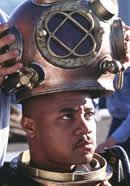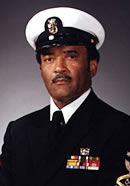|

|
|
Men
of Honor (2000)
Starring Cuba Gooding Jr., Robert De Niro,
Charlize Theron
based on events in the life of Carl Maxie Brashear |
| Reel
Face: |
Real
Face: |
 |
Cuba
Gooding
Jr.
Born: January
2, 1968
Birthplace:
The Bronx,
New York, USA |
|
 |
Carl
Maxie
Brashear
Born: January 19,
1931
Birthplace:
Tonieville, Kentucky,
USA
Died: July 25, 2006 (respiratory and heart ailments) |
|
|
 |
"Sometimes
I would come back from a run, and my artificial leg
would have a puddle of blood from my stump. I wouldn't
go to sick bay. In that year, if I had gone to sick
bay, they would have written me up. I didn't go to
sick bay. I'd go somewhere and hide and soak my leg
in a bucket of hot water with salt in it--an old remedy.
Then I'd get up the next morning and run." -
Carl Brashear
 Brashear
running with an artificial leg
Brashear
running with an artificial leg
(click image to enlarge)
|
Questioning the Story:

Was Robert De Niro's character, Billy Sunday, a real
person?
No, he was not a real person. According to the film's
press kit, the character of Billy Sunday, who was a Master
Chief Navy Diver and instructor at the diving school in
the movie, was "a composite of various Navy men."
In the film's press notes, screenwriter Scott Marshall Smith
wrote, "This isn’t a connect-the-dots biography.
I follow Carl’s life and career, but my goal was to
be true to his spirit, not his shirt size. Everyone wanted
the script to resonate as much as possible, so as a dramatist,
I sometimes took it up a level.”
Was there really an enemy sub underwater with Carl Brashear
when he worked to recover the nuclear bomb?
No, Carl Brashear was not dragged by an enemy sub, nor
was there one underwater at all when he was working to recover
the bomb. In an interview from About.com, Carl said that
the enemy sub was "completely stuck in there."
Did Carl Brashear really lose his leg in the same way that
the film depicts?
Yes, this part of the film is very accurate. In the U.S.
Naval Institute's oral history of Master Chief Boatswain's
Mate Carl M. Brashear, he was quoted saying the following
about the accident that occurred on March 23, 1966:
Just as I started to leave, the boat pulled on the pipe
that had the mooring line tied to it. That pipe came loose,
flew across the deck, and it struck my leg below the knee.
They said I was way up in the air just turning flips. I
landed about two foot inside of that freeboard. They said
if I'd been two feet farther over, I'd have gone over the
side. I jumped up and started to run and fell over. That's
when I knew how bad my leg was. -
Complete Oral History of Carl Brashear, U.S. Naval Institute
Just how bad was Carl Brashear's leg?
The
corpsmen on the ship placed two tourniquets on Brashear's
leg to try and stop the bleeding.
They didn't work very well at first because Brashear was
in such good physical condition and his leg was such a mass
of muscle, a corpsman said later in an interview. The lower
part of Brashear's leg was not torn off by the accident.
He instead suffered several compound fractures of both bones
in the lower leg.
In the following excerpt from the
U.S. Naval Institute's oral history of Master Chief Boatswain's
Mate Carl M. Brashear, Carl
said the following about the condition of his leg shortly
after the accident:
Then they were going to piece my leg back on and do plastic
surgery. Well, they were going to make my leg three inches
shorter than the other leg. When they took the bandage off,
my foot fell off. So they tried again, and it would fall
off. It got gangrene and got infected. Well, I was slowly
dying from that. So they transferred me up to Wiesbaden,
Germany. There the doctor said that he could fix me, but
it would take three years and could have me walking on a
brace. So I raised all sorts of hell in that hospital.
So he said, "Well, do you want to be air-mailed out
to the States?" That's the term he used. He said, "Do
you want to be air-mailed out to the States?"
I said, "Yes, sir! Air-mail me out of here!"
- Complete Oral history of Carl Brashear, U.S. Naval Institute
Why did Brashear eventually choose amputation over trying
to save his leg?
After several attempts by surgeons to save Brashear's leg,
persistent infection and necrosis plagued the leg. He convinced
them to amputate for this reason, and because he was told
that it could take several years to fix the leg. In his
oral history, he describes the amputation as follows:
 |
"So
they did a guillotine-type of operation, just chopped
it off, cleared up the infection. A while later he said,
"We didn't go high enough. We need to cut off another
inch and a half." So they cut off an inch and a
half to make sure they got it, and veed it out and sewed
it up. This was in July 1966." - Carl Brashear
 Brashear
after the amputation wearing the Navy
Brashear
after the amputation wearing the Navy
and Marine Corps Medal for heroism
in saving
lives. (click image to enlarge)
|
What type of tests did Carl Brashear have to pass in order
to remain an active U.S. Navy diver?
 |
Carl
Brashear had to pass a variety of strenuous physical
examinations. One exam involved climbing a ladder with
a set of weights strapped to his back equivalent to
the weight of two scuba tanks. Eventually, after prolonged
tests and diving exercises, Carl was put back on active
duty. He stayed on active duty for 12 more years, and
in 1970 Carl became the first black US Navy master diver.
 click
image to enlarge
click
image to enlarge
|
Did Carl Brashear really split up with his wife as the movie
implies?
Yes. He and Junetta Wilcoxson divorced in 1978 after
a 26-year marriage. In the years to follow, Carl Brashear
remarried twice, but divorced each time. The last marriage
ended in 1987.
Carl Brashear Interview Footage, Audio, and Photo Montage:
In
this school project, several students offer an honest look at the real Carl Brashear's life, which is portrayed onscreen by Cuba Gooding Jr. Watch video, see photos and listen to him speak about his life as a Navy diver.
Carl Brashear Related Images:
|
|
Pictured
left is Carl Brashear and Cuba Gooding Jr. on the set
of 20th Century Fox's Men of Honor. Carl served
as a technical advisor on the film. |
|
|
Pictured
left is a modern day U.S. Navy diver from Mobile Diving
Salvage Unit Two. The divers prepared on the deck of
the USS Grapple (ARS 53) to dive on the crash site of
Swissair Flight 111 off the coast of Peggy's Cove, Nova
Scotia, on Sept. 13, 1998. U.S. and Canadian forces
worked together in the retrieval of victims and aircraft
debris from the crash site. |
Link-to-Learn
More:
 U.S.
Naval Institute's Oral History of Carl Brashear (Interview)
U.S.
Naval Institute's Oral History of Carl Brashear (Interview)
 Diving
Heritage Site With Brashear Pics
Diving
Heritage Site With Brashear Pics
 Carl
Brashear's Personal Data, Transcript of Service, Medals,
Etc.
Carl
Brashear's Personal Data, Transcript of Service, Medals,
Etc.
 Listen to Navy/Marine Corps Radio Daily Newscast
Listen to Navy/Marine Corps Radio Daily Newscast
 U.S. Navy's
Official Web Site
U.S. Navy's
Official Web Site
 Living
With Limb Differences (Part on Carl Brashear) [PDF file]
Living
With Limb Differences (Part on Carl Brashear) [PDF file]
 The
Official Movie Site for Men of Honor
The
Official Movie Site for Men of Honor
 Men
of Honor /*** Roger Ebert's Review
Men
of Honor /*** Roger Ebert's Review
Watch the Men of Honor Movie Trailer:
|
|
|
|
